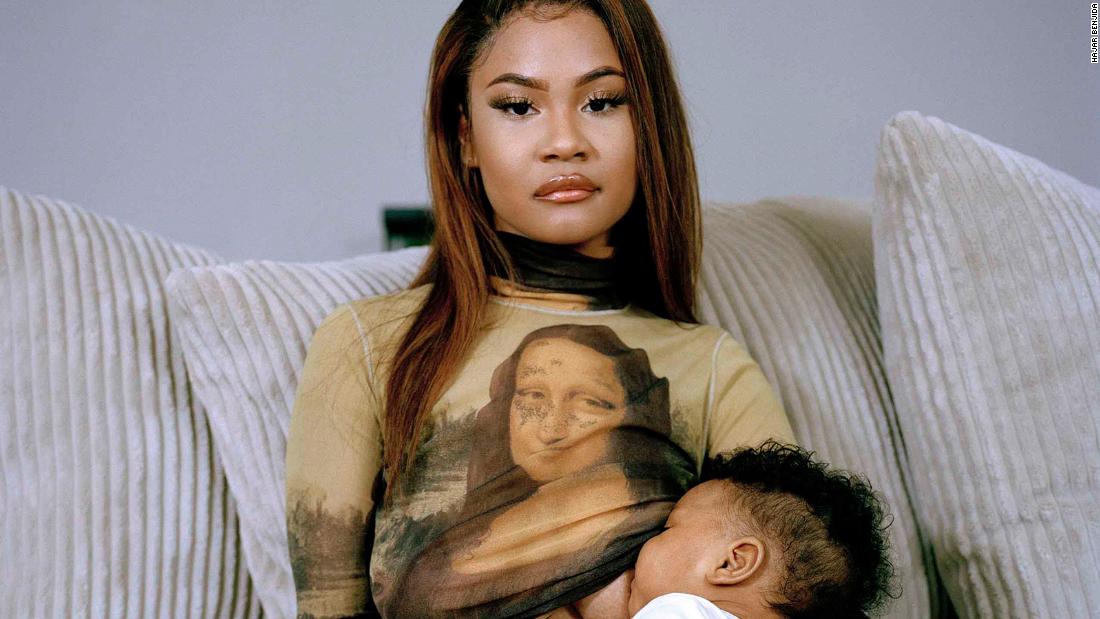
When Hajar Benjida began photographing exotic dancers around the Atlanta area, she didn’t want to take typical images of them performing on stage. Instead, she photographed many of the women at home, including Cleo, who had recently given birth to a baby boy named Andy.
One of Benjida’s striking images is composed like a modern Madonna and Child, with the then new mother cradling her son in her lap, eyes meeting the camera. Her mesh top — a vintage Jean Paul Gaultier piece with the Mona Lisa gazing out — is nudged up just high enough for Andy to breastfeed.
“Sometimes people forget (they) have families outside of the club,” Benjida said over a video call. “They just want to glamorize the life, or the performance they’ve seen on stage.”
The portrait, part of Benjida’s series titled “Atlanta Made Us Famous,” celebrates the lesser-credited players of the city’s famed hip-hop scene, which has been the launching pad for artists from T.I. and Ludacris to Young Thug and Playboi Carti. Through the series, the Dutch photographer, who was working in Atlanta at the time, turned her attention to who she believed to be the real kingmakers of the music industry: the exotic dancers at legendary clubs like Magic City.

Cleo and Andy at home. Credit: Hajar Benjida
“They play a really big part (in) the current hits that we hear,” Benjida said. “(The songs) get tested out in the clubs. When these women dance to it….the audience goes with it.”
The dancers, considered the “movie stars” of Atlanta, according to Lauren Greenfield’s 2015 documentary about Magic City, have the power to make or break a track through their song requests and enthusiasm for new music. Unreleased, unmixed tracks come straight from the studio to the club, and if they fare well, can be propelled straight to radio stations and eventually music charts.
“The DJs and the dancers are more like A&Rs,” said Diamond, a dancer in Greenfield’s documentary, referring to the talent scouts at record labels. “We know what we love to dance to and we know a hit when we hear it.”
A single frame
Benjida took posed portraits of the women backstage or at home with an intimate and soft sensibility. Instead of going for the allure of raw sex appeal or peformance, the dancers often appear relaxed but self-assured, gazing directly at the viewer. One woman holds her twins on her lap, while another lays supine with her hand resting above her pregnant belly.
Cleo lives in Stone Mountain, a suburb outside of the city, and at the time, in 2019, was commuting to work in different clubs during the week. Benjida spent the day with her at home, and though many images were posed, the moment she took the strongest frame was by chance.
“Mid-shoot she was breastfeeding her kid and I asked her for one shot,” Benjida said. “I didn’t even see the photo right away…so I really had to trust in that one shot.”

Cleo and Andy at home one year later. Credit: Hajar Benjida
But seeing the strength in the details — the similar hairstyles of Cleo and Leonardo’s enigmatic famous subject and the Renaissance-like composition, she knew the power of that single frame.
One year later, she returned to Stone Mountain to photograph the pair again — this time outside of their home. Like many of the images in “Atlanta Made Us Famous” the portrait radiates a sense of confidence, foregrounding the women who are the backbone of Atlanta’s hip-hop scene. Cleo holds Andy on her hip, her ombre orange hair matching the children’s McLaren sports car beside them. But here, if you look closely, there’s another subtle reminder of her motherhood: two matching orange toy cars tucked inside the platforms of her heels.